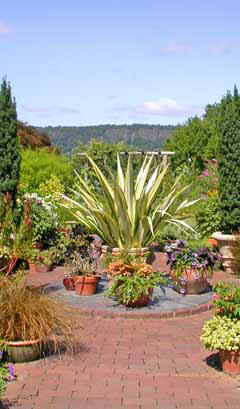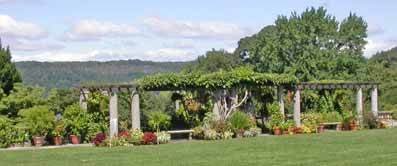Joseph Cooper
Photo Gallery
Wave Hill
The History of Wave Hill

A publishing scion, Appleton brought to Wave Hill such pioneering natural scientists as Thomas Henry Huxley. Huxley was astounded by the site, declaring the Palisades across the river one of the world's greatest natural wonders.
Theodore Roosevelt's family rented Wave Hill during the summers of 1870
and ‘71, when the future president was a youth of 12 and 13. Teddy's time here significantly deepened his love of nature and love of the outdoors that would later prompt him to secure the preservation of millions of acres of American parkland.
Mark Twain leased the estate from 1901-1903, setting up a treehouse parlor in the branches of a chestnut tree on the lawn. Of winter at Wave Hill he wrote, I believe we have the noblest roaring blasts here I have ever known on land; they sing their hoarse song through the big tree-tops with a splendid energy that thrills me and stirs me and uplifts me and makes me want to live always.
1903-1960 In 1903, George W. Perkins, a partner of J.P. Morgan, purchased Wave Hill House. Since 1895 he had been accumulating properties to create a great estate along the river including Oliver Harriman's adjacent villa on the site of what is now Glyndor House. Perkins devoted much of his extraordinary energy to planning the grounds so as to enhance the property's magnificent vistas. To the garden and greenhouses built by Appleton, Perkins added greenhouses, a swimming pool, terraces and the recreational facility that we now call the Ecology Building. The land was graded and contoured, rare trees and shrubs were planted on the broad lawns, and gardens were created to blend harmoniously with the natural beauty of the Hudson River highlands. Across the river, Perkin's involvement at the inception of the Palisades Interstate Park Commission was pivotal in preserving the Palisades.

The original house was built in Greek Revival style in 1843-44 by William Lewis Morris, a New York City attorney. The Morrises lived here until the death of Mrs. Morris in 1852. William Henry Appleton, a world renowned publisher, bought Wave Hill in 1866 from the Morris heirs. The Appletons used the place as a summer residence. It was leased in 1870-71 to New York banker Theodore Roosevelt, Sr. whose adolescent son developed a love of nature that endured through a lifetime as military hero, conservationist, Governor, and President. Another celebrated tenant, Mark Twain, made Wave Hill a social milieu of literary greats during 1901-03.
Financier George W. Perkins lived in Glyndor House. He bought Wave Hill House in 1903, and from 1909-1928 leased it to Dr. Bashford Dean, first curator of Arms and Armor at the Metropolitan Museum of Art. Dean gained Perkins' approval to build the Armor Hall wing to house his collections. The wing was designed by Fieldston resident, architect Dwight James Baum. Following Dr. Dean's death in 1928, choice pieces of the collection went to the Metropolitan Museum of Art where they are still on view today.
The Perkins' daughter, Dorothy, and son-in-law, Edward W. Freeman, remodeled the house in 1933. They leased the house to the great maestro Arturo Toscanini from 1942-45; and to the chief British delegates to the UN, Sir Gladwyn Jebb and Sir Pierson Dixon, from 1950-56. In 1960, the Perkins and Freeman families gave the Wave Hill estate to the City of New York.
Glyndor House This house, in Georgian Revival style, is the third to stand on this magnificent site overlooking the Palisades. The first was a Victorian style villa built in the 1860's by the New York financier, Oliver Harriman, called Nonesuch. It was purchased in 1895 by George Walbridge Perkins (1862 -1920). Perkins and his wife, Evelina Ball, remodeled and enlarged the house to include guest rooms and a ballroom with the professional assistance of C. Grant La Farge, architect and son of the famous stained glass artist and designer. Perkins named the transformed house Glyndor (a combination of letters from the names of his family).

George W. Perkins died at the age of 58 in 1920. In 1926, the house was struck by lightning and severely damaged. Mrs. Perkins had it demolished. The present building, designed by New York architects Butler and Corse, rose on the site in a year's time. In 1960, following Evelina Ball Perkins' passing, the Perkins and Freeman families gave the Wave Hill estate to the City of New York.